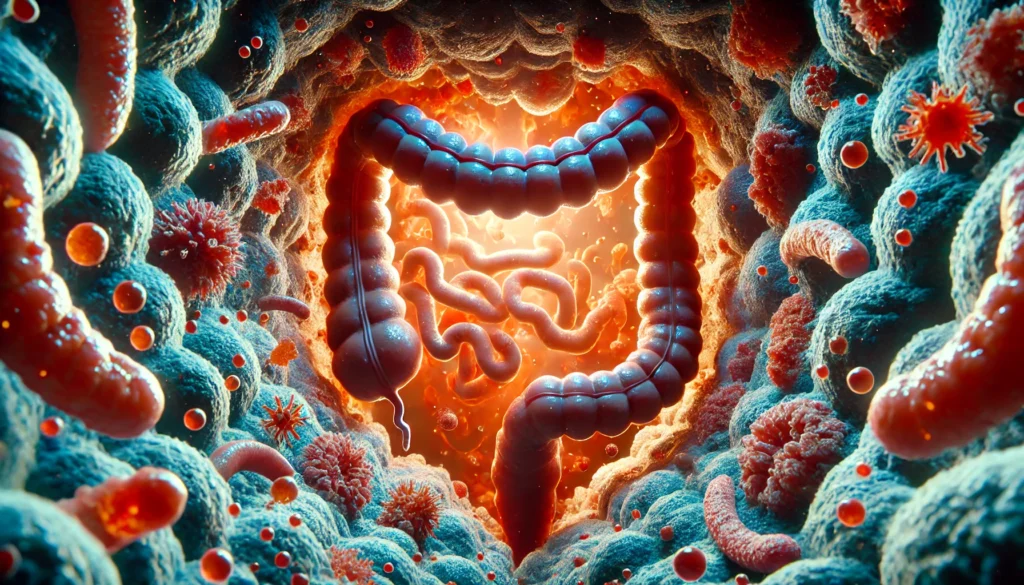Introduction
Few digestive symptoms are as uncomfortable and socially disruptive as bubble guts and diarrhea. The term “bubble guts” refers to a distinct gurgling or rumbling noise in the stomach and intestines, often accompanied by a churning sensation that signals impending loose stools. While it may sound casual or even humorous, the reality of experiencing these symptoms is far from amusing. For many individuals, especially those dealing with chronic episodes, the sensation can disrupt daily routines, diminish quality of life, and cause anxiety around meals, travel, or work.
You may also like: The Science of Gut Repair: How to Heal Leaky Gut Syndrome Naturally with a Proven Gut Healing Diet
Understanding what causes bubble guts and diarrhea is crucial for both managing immediate discomfort and preventing long-term gastrointestinal distress. The human gut is a complex system influenced by diet, hydration, stress, hormonal changes, microbial balance, and underlying disease processes. When this balance is disrupted, it can result in a range of symptoms that include bloating, urgency, abdominal pain, excessive gas, and unformed stools. While some episodes may stem from temporary irritants, others reflect deeper functional or inflammatory issues requiring medical attention.
This comprehensive article explores the multifaceted nature of bubble guts and diarrhea by examining their root causes, pathophysiology, associated conditions, and treatment options. We’ll also discuss diagnostic strategies, diet modifications, and when to seek help for persistent symptoms. Whether you’re seeking relief from occasional digestive upset or managing a recurring gastrointestinal disorder, understanding the physiology behind these symptoms is your first step toward lasting gut health.

The Gut’s Role in Digestive Regulation
To understand the phenomenon of bubble guts and diarrhea, we must first grasp how the digestive system functions under normal conditions. The gastrointestinal (GI) tract is responsible for breaking down food, absorbing nutrients, and eliminating waste. It relies on synchronized contractions of the intestinal muscles—a process called peristalsis—to move contents through the digestive tract. Simultaneously, digestive enzymes and fluids work to chemically break down food while facilitating nutrient absorption.
Bubble guts typically originate when this system becomes hyperactive or uncoordinated. Excess gas production, rapid motility, or increased sensitivity in the intestines can create audible gurgling noises and sensations of turbulence. This may or may not lead to diarrhea, which occurs when stool moves too quickly through the colon for water to be absorbed, resulting in loose, watery bowel movements.
The enteric nervous system, often referred to as the “second brain,” governs gut motility, secretion, and sensitivity. It works in tandem with the brain through the gut-brain axis, explaining why stress and emotional states can directly influence digestive function. Disruptions in this axis, combined with dietary triggers, infections, or chronic inflammation, can result in the familiar symptoms of bubble guts and diarrhea.

What Causes Bubble Guts and Diarrhea?
The causes of bubble guts and diarrhea are wide-ranging and often multifactorial. In many cases, the symptoms are transient, resolving on their own with minimal intervention. However, chronic or recurrent cases demand a closer look at underlying triggers.
Dietary indiscretion is a leading cause. Consuming excessive amounts of caffeine, alcohol, artificial sweeteners (like sorbitol or sucralose), or greasy and spicy foods can irritate the gut lining and accelerate motility. Certain individuals are more sensitive to lactose, fructose, gluten, or high-FODMAP foods, which ferment in the colon and produce gas and osmotic pressure.
Infections represent another significant contributor. Bacterial, viral, and parasitic pathogens—such as norovirus, E. coli, Salmonella, or Giardia—can cause acute gastroenteritis marked by bubble guts, cramping, and watery diarrhea. These infections often present suddenly and are accompanied by nausea, vomiting, fever, or dehydration.
Stress and anxiety are underrated yet potent causes. Psychological stress activates the hypothalamic-pituitary-adrenal (HPA) axis, releasing cortisol and other stress hormones that alter gut permeability, disrupt microbiota, and increase visceral sensitivity. This can lead to functional symptoms even in the absence of infection or inflammation.
Medications can also play a role. Antibiotics, for instance, can disturb the gut microbiome, leading to dysbiosis and post-antibiotic diarrhea. Certain antidepressants, antacids containing magnesium, and laxatives can also increase gut motility and fluid secretion, resulting in loose stools and abdominal noise.
Chronic conditions like irritable bowel syndrome (IBS), inflammatory bowel disease (IBD), celiac disease, and small intestinal bacterial overgrowth (SIBO) frequently include bubble guts and diarrhea among their hallmark symptoms. These conditions are complex and require targeted diagnostic and therapeutic strategies.

The Role of Gut Microbiota in Bubble Guts and Diarrhea
One of the most critical—and often overlooked—factors contributing to gastrointestinal symptoms is the state of the gut microbiome. The human gut is home to trillions of microorganisms that aid in digestion, immune regulation, and nutrient synthesis. When this microbial balance is disturbed, a condition known as dysbiosis can develop, triggering excessive fermentation, gas production, and altered bowel movements.
In cases of bubble guts and diarrhea, dysbiosis can amplify symptoms through several mechanisms. Certain bacterial strains produce gases like hydrogen, methane, and sulfur during carbohydrate fermentation, which can create the bubbling or churning sensation known as bubble guts. In some cases, this gas also increases pressure on the intestinal walls, prompting urgent bowel movements.
SIBO occurs when bacteria that normally reside in the colon migrate into the small intestine, where they ferment food prematurely and disrupt normal absorption. The result is bloating, bubbling, and diarrhea soon after eating. SIBO can be diagnosed through breath testing and treated with specific antibiotics or herbal antimicrobials.
Probiotic therapy, prebiotic fibers, and dietary diversity are essential tools for restoring microbial balance. However, indiscriminate use of supplements without understanding the root cause can backfire, especially if the gut lining is compromised or inflammation is present. Individualized treatment based on microbial testing can yield more effective results.
Diagnosing the Root Cause: When to Investigate Further
While occasional bubble guts and diarrhea may not warrant immediate concern, persistent or severe symptoms should be evaluated by a healthcare provider. A thorough diagnosis begins with a detailed history, including dietary habits, stress levels, medication use, travel history, and family history of GI disorders.
Basic laboratory tests may include blood counts, electrolyte panels, inflammatory markers (like CRP or ESR), and thyroid function tests. Stool analysis can reveal pathogens, occult blood, or markers of inflammation like calprotectin.
For individuals with chronic symptoms, advanced diagnostics may be needed. Breath tests can assess for SIBO or carbohydrate malabsorption. Endoscopy or colonoscopy can identify structural abnormalities, inflammation, or mucosal damage. Imaging techniques such as CT scans or abdominal ultrasound may be used to rule out obstruction, tumors, or other anatomic causes.
Functional GI disorders like IBS are often diagnosed based on the Rome IV criteria, which rely on symptom patterns rather than structural findings. However, ruling out other causes is essential to avoid misdiagnosis and ensure effective treatment.

Diet, Lifestyle, and Prevention Strategies
Addressing bubble guts and diarrhea requires a comprehensive approach that targets diet, lifestyle, and underlying pathophysiology. The first step is identifying and eliminating dietary triggers. Keeping a symptom diary can help isolate problematic foods or patterns, such as specific meals, caffeine intake, or stress-related flare-ups.
The low-FODMAP diet—designed to reduce fermentable carbohydrates—has shown significant success in managing IBS-related symptoms. Gradually reintroducing foods helps identify individual sensitivities while maintaining nutritional balance.
Hydration is key. Diarrhea can quickly lead to fluid and electrolyte imbalances. Oral rehydration solutions containing sodium, potassium, and glucose are often more effective than plain water.
Stress management cannot be overlooked. Practices such as mindfulness, meditation, yoga, and cognitive-behavioral therapy (CBT) help regulate the gut-brain axis and reduce symptom frequency. Regular exercise, adequate sleep, and structured routines contribute to overall gut stability.
Long-term prevention also involves careful use of medications. Overuse of NSAIDs, laxatives, or acid-suppressing drugs can compromise gut integrity. Probiotic support and dietary fiber can enhance mucosal protection and improve motility, but should be tailored to the individual’s needs.
Medical and Therapeutic Interventions
When lifestyle and dietary modifications are insufficient, pharmacological interventions may be necessary. Antispasmodics such as dicyclomine or hyoscyamine can help calm intestinal contractions. Antidiarrheals like loperamide are useful for short-term symptom control, though not ideal for chronic use without a known diagnosis.
For those with IBS-D (diarrhea-predominant IBS), medications like rifaximin (a non-absorbable antibiotic) and eluxadoline may offer symptom relief. Tricyclic antidepressants at low doses can reduce visceral hypersensitivity and improve motility.
Infections may require targeted antibiotics, antiparasitic agents, or supportive care depending on the causative organism. Post-infectious IBS is a recognized condition in which GI symptoms persist after the initial infection has resolved, and may benefit from a combined approach involving microbiota restoration and neuromodulation.
For IBD or celiac disease, immunomodulatory drugs, biologics, and strict dietary adherence (such as a gluten-free diet for celiac patients) are essential. These conditions require specialist management and long-term monitoring.
Ultimately, effective treatment hinges on accurate diagnosis. A multidisciplinary team—including a gastroenterologist, registered dietitian, and sometimes a psychologist—can provide comprehensive care and prevent recurrence of symptoms.
Frequently Asked Questions
1. What causes bubble guts and diarrhea after eating?
Bubble guts and diarrhea after eating are often caused by rapid gastric emptying, food intolerances, or excessive fermentation of carbohydrates. High-fat meals, dairy products, caffeine, and artificial sweeteners are common triggers. These substances can stimulate motility and irritate the intestinal lining, resulting in bubbling sensations and loose stools. In some cases, it may also be due to stress or an underlying condition like IBS or SIBO.
2. Are bubble guts and diarrhea always a sign of illness?
Not necessarily. Occasional episodes can result from diet changes, temporary stress, or mild infections. However, if the symptoms become frequent, severe, or are accompanied by weight loss, blood in the stool, or fever, they could indicate a more serious condition such as IBD, infection, or celiac disease. Chronic symptoms warrant a thorough medical evaluation to rule out these possibilities.
3. How can I quickly relieve symptoms of bubble guts and diarrhea?
Quick relief may involve fasting for a few hours, staying hydrated, and consuming bland foods like bananas, rice, applesauce, and toast (the BRAT diet). Over-the-counter medications such as loperamide may help reduce diarrhea, while simethicone can reduce gas. However, these measures are temporary, and persistent symptoms should be medically investigated.
4. What role does anxiety play in triggering these symptoms?
Anxiety significantly impacts gut function via the gut-brain axis. Stress can increase gut motility, reduce enzyme secretion, and alter microbiota composition, all of which contribute to bubble guts and diarrhea. Managing stress through relaxation techniques and therapy often improves gastrointestinal symptoms, especially in functional disorders like IBS.
5. Can bubble guts occur without diarrhea?
Yes. Bubble guts may occur as a result of gas accumulation, excessive fermentation, or intestinal motility changes without necessarily leading to diarrhea. Some individuals experience gurgling and discomfort without a subsequent bowel movement, which may still reflect underlying dysbiosis or functional motility disorders.
6. Is it safe to use antidiarrheal medications regularly?
Frequent use of antidiarrheal medications without identifying the underlying cause can be problematic. These drugs may mask symptoms of serious conditions or lead to complications like constipation or toxic megacolon in the context of infections. Long-term use should be guided by a healthcare provider.
7. How do I know if my symptoms are food-related?
Keeping a food and symptom journal can help correlate meals with digestive reactions. If specific foods consistently trigger bubble guts and diarrhea within a few hours of consumption, they may be the culprits. An elimination diet under the guidance of a dietitian can help pinpoint intolerances such as lactose, gluten, or FODMAPs.
8. Are probiotics helpful for treating bubble guts and diarrhea?
Probiotics may help rebalance gut microbiota and reduce symptoms, particularly when dysbiosis or post-antibiotic diarrhea is involved. However, they are not a one-size-fits-all solution. The effectiveness of probiotics depends on the specific strain and the condition being treated. Clinical-grade formulations should be chosen based on medical advice.
9. What diagnostic tests are best for persistent symptoms?
For persistent bubble guts and diarrhea, stool studies, blood tests, and breath tests for SIBO or carbohydrate malabsorption are often used. Imaging or endoscopy may be needed to rule out IBD or structural abnormalities. Comprehensive testing allows for targeted treatment and reduces the risk of misdiagnosis.
10. Can these symptoms indicate colon cancer?
While bubble guts and diarrhea are not typical symptoms of colon cancer, any persistent change in bowel habits, especially when accompanied by blood in the stool, unexplained weight loss, or fatigue, should be taken seriously. Colonoscopy remains the gold standard for evaluating these risks, particularly in individuals over 45 or with a family history of colorectal cancer.

Conclusion
Bubble guts and diarrhea are more than just awkward inconveniences—they can be warning signs of deeper dysfunction in the gastrointestinal system. Whether triggered by dietary indiscretion, microbial imbalances, stress, or underlying disease, these symptoms deserve thoughtful attention and informed action. Understanding what causes bubble guts and diarrhea helps patients and clinicians navigate a maze of potential diagnoses and treatments, from simple dietary changes to complex medical interventions.
Effective management begins with awareness, continues through evidence-based strategies, and thrives on individualized care. By embracing a holistic approach that integrates physiology, psychology, and nutrition, lasting relief becomes a realistic and achievable goal. Whether you’re seeking answers for sudden discomfort or managing chronic digestive challenges, the journey toward gut health is one of empowerment, science, and healing.
Further Reading:
What can cause stomach churning?



